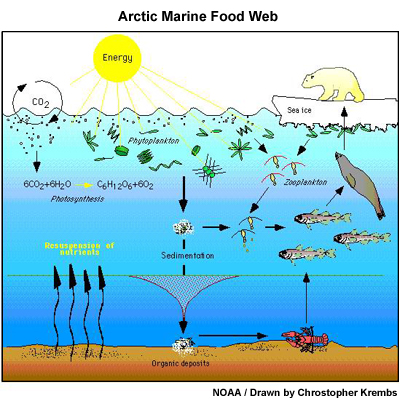Arctic Ecosystems

This diagram shows a simple representation of the Arctic food web: the complex arrangement of predator-prey relationships within an ecosystem. In the most elemental link, phytoplankton use energy from the sun to combine CO2 from the atmosphere with water to create glucose, a simple sugar. This process is called photosynthesis. Through this simple conversion of solar energy to food, they form the beginning of the entire food web. For this reason, we call the phytoplankton primary producers.
Moving up the food chain, zooplankton graze on and consume phytoplankton, and sometimes each other! Many animals consume zooplankton, including fish and birds. Of course, larger fish eat smaller fish, seals eat all fish, and polar bears eat seals.
Phytoplankton, zooplankton, and other animals that evade being consumed eventually die and fall to the seafloor. Some are consumed by scavengers, others by bacteria. In this way, most carbon-rich material that falls to the seafloor is recycled and kept within the ecosystem. The rest is buried with the sediments.
Open another view of the Arctic Ecosystem in a new window.
Open a summary graphic of photosynthesis in a new window.
